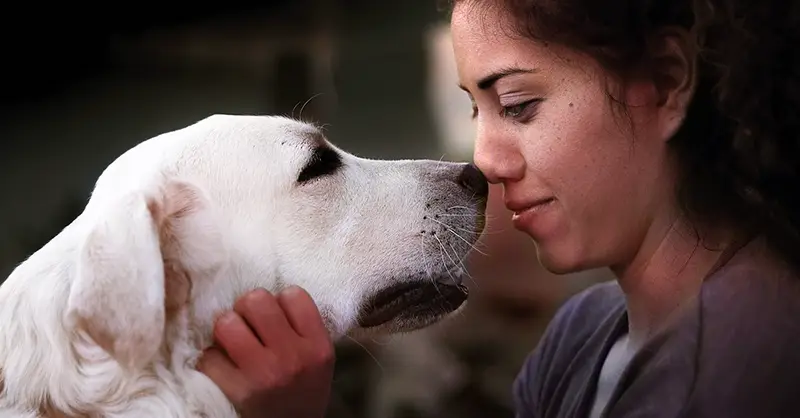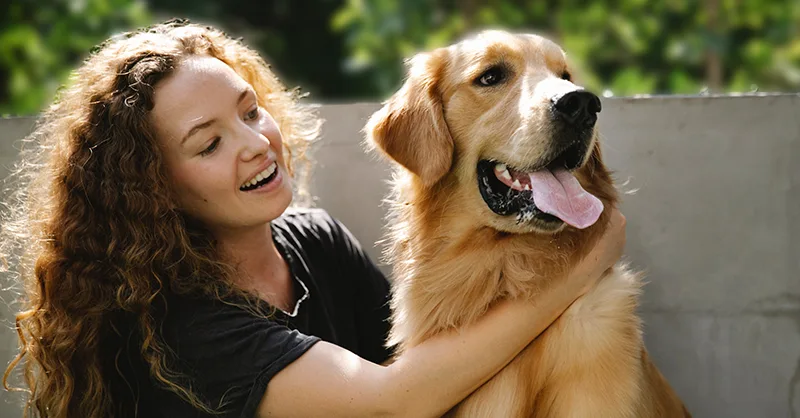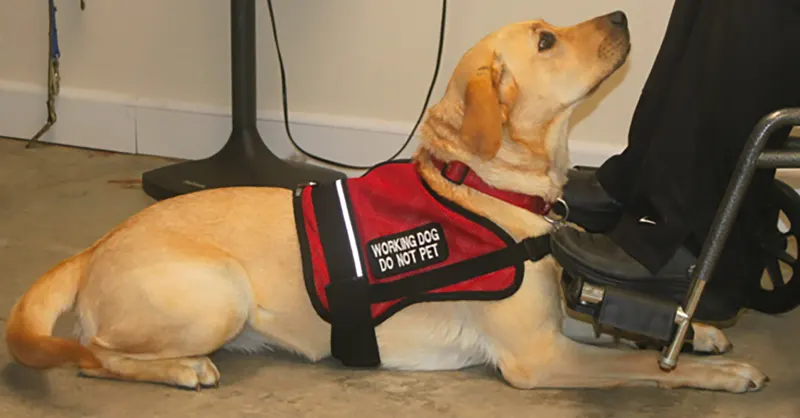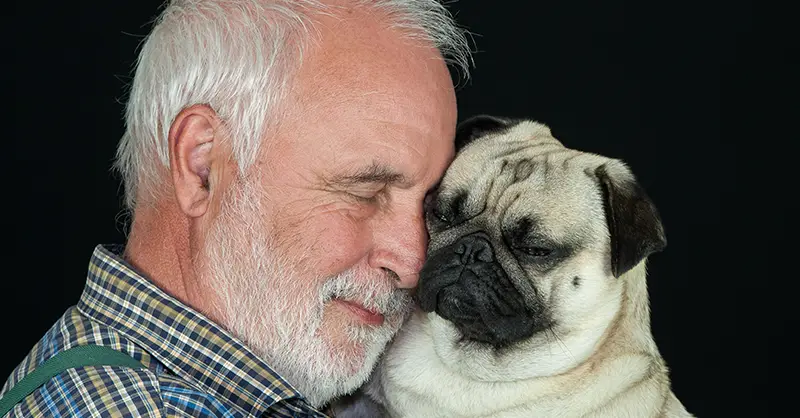Archive for the ‘Psychiatric Service Dog’ Category
Older adults have always made vital contributions to society, family, and history, yet they struggle increasingly with loneliness, depression, and other mental or neurological disorders. According to the World Health Organization (WHO), roughly 20% of older adults aged 60 or over have a mental health disorder. To ensure the safety and health of this population, it’s essential to identify ways to address their mental health concerns. One way to help older adults is with psychiatric service dogs.
What is a Service Dog?Emotional support dogs (ESA), therapy dogs, and service dogs help people with mental or emotional disabilities or disorders. Of these three, only handlers of service dogs maintain the rights under three federal laws:
The Americans with Disabilities Act (ADA) Air Carrier Access Act (ACA) The Fair Housing Act (FHA)These federal laws protect the right of people with disabilities to have their service dogs with them at all times. Whether it’s in a public park (ADA), on an airplane (ACA), or in a “no pets allowed” apartment (FHA), service dogs are able to remain with their handler. Unlike other animals, service dogs can enter and stay in public areas where pets are not allowed.
According to the ADA, a service dog must:
have specific service dog training that completes an essential task for a particular disability. assist with accomplishing a vital daily activity for a person with a qualifying disability. be essential to their handler.A few examples of service dogs are:
Mobility assistance dogs Guide dogs for people who are vision impaired Diabetic alert dogs Autism support dogs Psychiatric service dogsAlthough older adults may benefit from any of the service dogs listed above, psychiatric service dogs are ideal for helping those with mental health conditions.
What is a Psychiatric Service Dog?Psychiatric service dogs (PSD) are specially trained to help people with psychiatric or neurological disabilities. A PSD may receive training to help older adults in the following ways:
Obtain medication during psychiatric emergencies or severe depression. Alert their handler to medication administration times. Serve as a physical barrier between their handler and a distressing situation or object. Enter a room before their handler to ensure safety. Guide their handler to the designated exits during an emergency. Awaken their handler when their handler is groggy from medication. Wake their handler from nightmares. Prompt their handler to eat or bathe. Prompt their handler to exercise or perform a healthcare task. “Ground” – reducing anxiety through tactile stimulation – their handler when their handler becomes overwhelmed or distressed. Lead their handler to safer areas. Obtain assistance when their handler falls into an emergency situation.The list above only offers a brief snapshot of tasks a psychiatric service dog can perform for older adults. Which job a PSD is ultimately trained for depends on the needs of their handler.
Older Adults and Mental HealthIt’s just as essential for older adults to get help for their mental health as it is for younger adults. For example, according to the Centers for Disease Control (CDC), older adults have a higher risk for depression than the general population.
Roughly 80% of adults over 60 have at least one or more chronic illnesses, and adults with a chronic disease are at a higher risk for depression. About 1% to 5% of older adults have major depression. The rate of major depression is higher in older adults who require home healthcare (13.5%).Adults over the age of 60 are also more prone to developing Alzheimer’s disease, a progressive disease resulting in memory loss. The CDC states that the number of older people with Alzheimer’s disease doubles every 5 years after age 65. People with Alzheimer’s may forget to take medication, get lost from home, or become irritable or depressed.
In the United States, loneliness among older adults is becoming a problem. One in three older adults struggles with loneliness. Although social isolation may contribute to loneliness, being alone is not always a factor. Some older adults who live surrounded by family and friends may still feel lonely. According to the World Health Organization, loneliness can lead to depression, negatively impact the quality of life, and shorten a person’s life span.
Psychiatric service dogs can help seniors that suffer from severe mental health issues due to loneliness and depression. How Can Psychiatric Dogs Help Geriatric Mental Health?People seeking solutions for mental health problems in the elderly may find that psychiatric service dogs are excellent alternatives. They are great companions, and PSDs serve as a valid assistive option for older people with mental health disabilities. By offering both company and physical assistance, a psychiatric service dog can significantly alleviate psychiatric and neurological symptoms.
Can Psychiatric Service Dogs Help with Dementia?PSDs help adults with Alzheimer’s disease or dementia safe in several ways. They can be trained to assist in routine activities like eating, dressing, or taking medications. A psychiatric service dog can also prompt people with dementia to perform their regular daily routines, which can help improve an older person’s quality of life. A psychiatric service dog can prevent an older adult from wandering or getting lost, either by guiding them home or alerting others. Additionally, a GPS locator can be attached to a PSD’s vest or collar, helping to alert loved ones if their older relative wanders away.
Do Psychiatric Service Dogs Reduce Symptoms of Depression or Anxiety?Pet owners are typically less lonely than non-pet owners. However, psychiatric service dogs are more than pets. Although they do provide a close presence, they also perform tasks that can assist an older person in times of need. Normal pets can sometimes overwhelm older adults with mental illness because pets aren’t trained to work with their diagnosis. PSDs, on the other hand, are trained for the specific purpose of working with individuals who have a psychiatric or neurological health conditions. The dog will know when to jump into action and help their handler, making them an indispensable part of the handler’s life and safety.
Psychiatric Service Animals and Mental Health ServicesA 2019 study published in the journal Frontiers of Veterinary Science found that 46% of psychiatric service dog owners saw their need for mental health services decrease. These PSDs typically performed more than one task for their owner, from grounding (94%) to blocking other people (42%). For older adults, a PSD can be a life-changing experience while also reducing the need for health services.
Improving Geriatric Mental Health with a PSDCaring for the elderly shouldn’t only consist of doctor’s visits, medications, and hospital beds. Sometimes, including treatments that are outside the box — like utilizing a psychiatric service dog — can reduce the need for medical care and keep older adults safe. A psychiatric service dog can not only help geriatric mental health, but it can boost their physical health and overall satisfaction with life.
See if your mental disability qualifies for a psychiatric assistance dog. Get an PSD Letter assessment from a licensed medical professional.
Humans have used dogs throughout history to help them with all kinds of life’s hardships. Whether it’s helping to gather sheep, pull sleds through thick snow, or protect the home, dogs have been at humanity’s side throughout the millennia.
Dogs are a human’s best friend, but it takes a special kind of dog to become a service dog. Service dogs are exceptionally well-trained dogs that perform tasks for a person with a physical or mental disability. For example, a service dog can help guide people with vision problems or detect impending seizures in someone with epilepsy. Becoming a service dog requires an intelligent, well-behaved, and attentive temperament.
As remarkable as service dogs are, a psychiatric service dog (PSD) is exceptional. Psychiatric service dogs, which are trained to assist people with mental illnesses, are in a league of their own. For these dogs to perform their tasks well, their temperament and focus must be exceptional.
Psychiatric service dogs help to keep children with behavioral concerns from running away or wandering into danger. For people who struggle with self-injurious behaviors, psychiatric service dogs can assist in preventing them from hurting themselves. In the case of psychiatric service dogs, these canines not only have to be attentive, but they must also have the ability to act on a task without taking direction. This level of independence calls for the most intelligent — and perceptive — dogs.
Top 8 Psychiatric Service Dog BreedsAlthough any dog can receive training as a service dog, it’s important to choose a dog with the right temperament, intelligence, and reliability. The following list is the nine best dog breeds for psychiatric dogs.
1. Labrador RetrieverLabradors are notoriously friendly, and they bond quickly with their owners. Their temperament is calm, confident, and friendly. Labrador Retrievers are known for being attentive and quick to respond. These dogs are classic service dogs, well-known for their high level of intelligence and alertness. Though hardworking, Labrador Retrievers are also easy-going and patient, qualities essential in psychiatric service dogs.
2. Doberman PinscherDobermans have a reputation for being guard dogs because of their stature and strength. However, Dobermans also make effective psychiatric service dogs. They’re eager to please and alert to their environment, enabling them to spot and halt impending mental health crises. Because they’re protective by nature, they bond very tightly with their owners and can intervene gently in cases of self-injury.
3. American BoxerAmerican Boxers are sturdy and robust dogs built with compact muscle. They may appear more fitting as guard dogs, but these dogs also have a soft side. Their size allows them to intervene gently in mental health crises without hurting their owner. Protective, attuned to human behaviors, and loyal, American Boxers make ideal psychiatric service dogs.
4. PoodleMuch more than a pretty face, Poodles are intelligent and highly trainable. Most Poodles have a peaceful temperament and aren’t prone to developing anxious traits. They’re also eager to please and highly perceptive, enabling them to notice psychological triggers and intervene.
5. LabradoodleLabradoodles are known for being attentive to their owner and eager to please. Very attuned to their owner’s emotions, they can respond and react to prevent unsafe situations. Labradoodles have high levels of intelligence and can adapt quickly to different environments. Laidback and calm, Labradoodles make an excellent choice as a psychiatric service dogs.
Are you training your dog to become your Psychiatric Service Dog?Organize your training sessions by using this free sample Service Dog Training Log, provided by Service Dog Certifications.
6. Golden RetrieverGolden Retrievers add sunshine to anyone’s day. These dogs are sharp and quick to respond. Although Golden Retrievers seem more fun-loving than hard-working, they’re very task-oriented and want to please. Golden Retrievers are also quick to learn and respond well to positive reinforcement. With their intelligence and obedience, Golden Retrievers are great psychiatric service dog candidates.
7. German ShepherdGerman Shepherds, known for being courageous and sharp, are often utilized as police or military canines. These qualities make them ideal for law enforcement and useful as psychiatric service dogs. Their willingness to assist, observe nature, and obey can help in any mental health situation. It’s their loyalty, stable temperament, and gentle soul, however, that make German Shepherds superior psychiatric service dogs.
8. Border CollieBorder Collies are a herding breed, and their desire to look after their “flock” make them watchful and focused psychiatric service dogs. They are quick to intervene without becoming anxious and are naturally intuitive. Collies also function well in family environments because of their collaborative and affectionate nature. During downtime, Border Collies are also silly and love to snuggle, perfect for psychiatric disorders who require a little boost in mood.
A Psychiatric Service Dog Is More than a PetAlthough pets, in general, may benefit the mental health of those they live with and emotional support animals (ESA) also provide comfort and companionship to people with mental health or emotional disorders, psychiatric service dogs go the extra mile to provide a task for their owners that, at a given time, might even save their life.
Whether it’s keeping an autistic child from straying or reminding a person with depression to take their medication, psychiatric service dogs enable people with psychiatric disorders to experience a better life. Like dogs have always done for humans, psychiatric service dogs help humans overcome life’s hardships.
See if your mental or emotional disability qualifies for a psychiatric assistance dog. Get an PSD Letter assessment from a licensed medical professional.In a 2018 survey of Assistance Dogs International members, only 1.5% of their members had psychiatric service dogs. Compared to the largest service dog group (mobility service dogs at 48%), psychiatric service dogs represent a small portion of all service dogs. Interestingly, psychiatric disorders are common.
According to statistics from the National Institute of Mental Health (NIMH), 5.2% of adults in the United States have a serious mental illness. When taking the number of psychiatric service dogs into account, along with the percentage of adults who have a serious emotional or mental disorder, it appears that psychiatric service dogs may have a larger role to play in the future.
What Can Psychiatric Service Dogs Provide?Psychiatric service dogs (PSD) receive extensive training to perform tasks needed by people with a mental illness or disorder. Because they are essential to an individual’s safety and wellbeing, psychiatric service dogs are protected under federal laws such as the Americans with Disabilities Act (ADA), Air Carrier Access Act, and the Fair Housing Act (FHA). These laws not only allow service animals — like psychiatric service dogs — into public areas where typically no pets are allowed, but they also enable service dogs to travel and live with their handlers.
Why are service dogs given so much freedom to remain with their handlers? Because service dogs are vital to the health and well-being of their handlers. Service dogs are also considered “reasonable accommodations” for a person’s disability, protecting the rights of a person with a disability.
Psychiatric service dogs, in particular, assist people with emotional or mental disorders. The assistance is typically an action or task that would be challenging or impossible for the person with the disability to perform on their own. Here are some examples of the kind of services a PSD can provide:
Circle their handler during a crisis episode to keep strangers and crowds at a safe distance. Lead their handler to exit during a panic attack or overcrowded situation. Serve as a barrier between their handler and a stranger in close quarters (elevator, small rooms, etc.) Nudge or paw at the handler to break a dissociative stance. Assess an area for intruders or strangers when entering a room or a home. Contact emergency through a K-9 rescue phone or another method should a psychiatric crisis arise. Nudge or paw at their handler or get assistance if their handler begins to perform self-injurious behaviors.There are no limits to what tasks a psychiatric service dog can do for its handler. What’s important is that the PSD is trained well and can perform the tasks correctly. The tasks should be relevant to their handler’s psychiatric disorder and contribute to their health and independence.
Wonder if you qualify for a Psychiatric Service Dog? Get an assessment from a licensed medical health professional. If you qualify, they can issue a PSD Letter so that you confidently can train and own a PSD. Train Your Own Psychiatric Service DogThe ADA defines a service dog as a dog trained to perform a specific action to help a person with a disability. Although training a service dog is vital, the ADA does not require a dog to be professionally trained. In short, a handler may train their own dog.
Purchasing a professionally trained psychiatric service dog is convenient but has drawbacks. For example, a trained service dog can cost anywhere from $15,000 to $50,000, depending on the dog and what tasks it will need to provide. In addition, psychiatric disorders are very subjective, and the symptoms vary significantly from person to person. Therefore, having a service dog that is individualized to the needs of its specific handler is essential.
For people who are looking to train their own psychiatric service dog, there are two ways to approach the situation:
Outsource portions of the training that don’t require individualized tasks, like the Public Access portion of the training. Perform all the training yourself.Before starting training, it’s vital to assess what tasks are necessary for the dog to perform. Collaborating with a physician or mental health professional can provide a solid framework. Once the required tasks are identified, it’s time to find the right dog.
1. Search for the Right Psychiatric Service DogFinding a dog with the ideal temperament is crucial to a service dog’s success. Good psychiatric service dog candidates are:
Calm and do not startle easily. Eager to please. Likes social interaction with people and other animals. Intelligent, alert, and attentive. 2. Start Socialization and Basic SkillsSocializing service dog candidates right away places them on the right track for training. Exposure to new places, people, and situations allows the dog to develop a tolerance to different external stimuli. Fostering a dog’s comfort level in a variety of locations makes training easier and sets the dog up for success. Training a dog on their basic skills (sit, stay, heel, etc.) gives handlers a good idea of how receptive a service dog candidate is to training. Ideal candidates should be eager to learn and not tire or get distracted easily.
3. Public Access Skills and Individual Response TrainingPublic access skills are vital to having a safe and effective service dog. For a service dog to remain in public areas with its handler, the dog must behave safely and always under the handler’s control. Training should occur in different locations for a dog to fulfill public access test requirements. Practicing in various situations allows the dog to gain comfort in following directions, even in new and distracting environments. Service dogs are known for their exemplary behavior, which comes through temperament and training.
When training a dog to carry out individualized tasks, it’s important to choose tasks a dog can reasonably perform. Training a dog on tasks that are not realistic for them to perform only sets the dog and the handler up for disappointment and frustration. Choose tasks that are important and can be accomplished consistently. Provide the PSD candidate ample opportunities to practice through simulated events.
Show that your Psychiatric Service Dog has mastered the Public Access Test.Get your Handler-Certified Public Access Test certificate. Keeping A Training LogWhen training a psychiatric service dog, it’s advised to keep a service dog training log for every session. Keeping a training log serves 4 benefits:
It keeps the training and trainer organized. It ensures that the quality of the training is upheld or even improved. The training log helps to identify strengths and weaknesses and what areas might need to be trained more often. And finally, the training log serves as proof of training if the handler ever needs to provide this information.The training log does not need to be complex. A page with the date, training location, commands and prompts used, as well as rating the service dog’s performance, can help to keep track of the progress.
You can start your training log by downloading this free sample Service Dog Training Log, provided by Service Dog Certifications.
Psychiatric Service Dog and Mental HealthUnlike emotional support animals, service dogs must have public access skills and individual task response training. Repetition and positive feedback is the key to owning an effective service dog training. And psychiatric service dogs need to excel in the training, just like all other types of service dogs.
With patience and discipline, psychiatric service dogs can assist their handlers in life-altering ways, giving them back a piece of the good life their mental disorder took from them.







